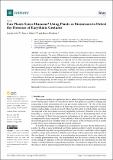Can Plants Sense Humans? Using Plants as Biosensors to Detect the Presence of Eurythmic Gestures
Author(s)
de la Cal, Luis; Gloor, Peter A.; Weinbeer, Moritz
Downloadsensors-23-06971-v3.pdf (3.057Mb)
Publisher with Creative Commons License
Publisher with Creative Commons License
Creative Commons Attribution
Terms of use
Metadata
Show full item recordAbstract
This paper describes the preliminary results of measuring the impact of human body movements on plants. The scope of this project is to investigate if a plant perceives human activity in its vicinity. In particular, we analyze the influence of eurythmic gestures of human actors on lettuce and beans. In an eight-week experiment, we exposed rows of lettuce and beans to weekly eurythmic movements (similar to Qi Gong) of a eurythmist, while at the same time measuring changes in voltage between the roots and leaves of lettuce and beans using the plant spikerbox. We compared this experimental group of vegetables to a control group of vegetables whose voltage differential was also measured while not being exposed to eurythmy. We placed a plant spikerbox connected to lettuce or beans in the vegetable plot while the eurythmist was performing their gestures about 2 m away; a second spikerbox was connected to a control plant 20 m away. Using <i>t</i>-tests, we found a clear difference between the experimental and the control group, which was also verified with a machine learning model. In other words, the vegetables showed a noticeably different pattern in electric potentials in response to eurythmic gestures.
Date issued
2023-08-05Department
Massachusetts Institute of Technology. Center for Collective IntelligencePublisher
Multidisciplinary Digital Publishing Institute
Citation
Sensors 23 (15): 6971 (2023)
Version: Final published version